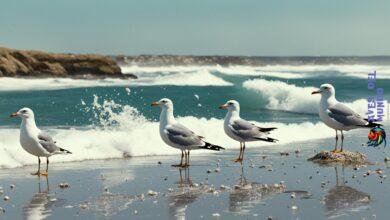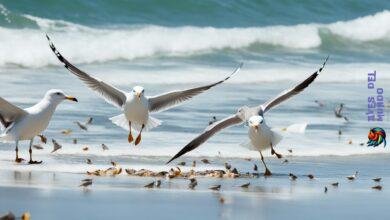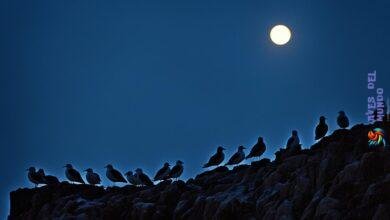Feeding seagulls may seem harmless and even enjoyable, but have you considered the environmental impact it can have? The Massachusetts Department of Conservation and Recreation strongly advises against feeding gulls due to various reasons that affect their health, behavior, and the overall ecosystem.
When you feed gulls, you potentially expose them to the risk of disease transmission. Gulls that rely on handouts from humans may suffer from long-term health problems and become more susceptible to diseases, compromising their well-being. Feeding distractions also put them at risk of accidents and injuries that could have been avoided if they were focused on natural foraging.
Furthermore, the concentration of gulls in certain areas, particularly near bodies of water, can lead to water quality issues. Their droppings can introduce bacteria and pathogens into the water, posing risks to the ecosystem and potentially to human health as well.
It is crucial to recognize the negative consequences of feeding seagulls and encourage their natural foraging behavior. By refraining from feeding them, you contribute to their overall well-being and help maintain a healthy and balanced ecosystem.
Risks of Feeding Gulls
Feeding gulls with items like bread, crackers, and french fries can have serious consequences for their health and well-being. While it may be tempting to share your food with these birds, it’s important to understand the negative effects it can have on their feeding habits and the overall ecosystem.
Seagull feeding habits are naturally designed to include a variety of foods that provide the necessary nutrients for their survival. However, when gulls are fed with nutritionally inferior human foods, they are at risk of experiencing long-term health problems.
Furthermore, feeding seagulls can contribute to the transmission of diseases among gulls themselves, as well as other bird species and even humans. The close proximity between humans and gulls during feeding activities increases the likelihood of disease transmission, posing risks to both wildlife and public health.
By feeding gulls with an artificial diet, you disrupt their natural foraging behavior and dependency on human handouts, compromising their ability to find food in their natural habitats.
To maintain the overall well-being of these birds and promote a healthy ecosystem, it is crucial to allow gulls to forage naturally. By refraining from feeding them and respecting their natural feeding habits, you can contribute to the preservation of their health and the balance of their ecosystem.
The Consequences of Feeding Seagulls
Feeding seagulls can have significant consequences for both their health and the environment. By understanding these consequences, we can make more informed decisions about our interactions with these birds and the impact we have on their overall well-being.
Here are some key consequences of feeding seagulls:
- Seagull Feeding Habits: Seagulls have evolved to rely on a diverse range of natural food sources to meet their nutritional needs. Feeding them with nutritionally poor human foods disrupts their natural feeding habits and may lead to malnutrition and long-term health problems.
- Risk of Disease Transmission: Close contact between humans and seagulls during feeding can increase the risk of disease transmission. Gulls can spread diseases to other gulls, other bird species, and even humans, potentially leading to outbreaks and health hazards.
- Dependency on Handouts: Feeding seagulls fosters dependency on human handouts, disrupting their natural foraging behavior and compromising their ability to find food in their natural habitats. This dependency can lead to long-term negative impacts on their survival and overall population dynamics.
- Environmental Imbalance: Encouraging gulls to congregate in specific areas for feeding can disrupt the natural balance of the ecosystem. It can lead to increased competition among gulls, displacement of other bird species, and potential water quality issues due to concentrated droppings.
By recognizing and respecting the risks associated with feeding seagulls, we can play an active role in preserving their health, promoting a harmonious coexistence, and maintaining the ecological balance of our environment.
Safety Concerns of Feeding Gulls
Feeding gulls can have unintended safety consequences for both humans and the gulls themselves. Seagulls, known for their scavenging behavior, can become distracted from their surroundings when focused on acquiring food from humans. This distraction puts them at an increased risk of accidents or injuries, especially in areas with fast-moving traffic or machinery.
Gulls that rely on human handouts may be less aware of potential dangers and more prone to accidents. By engaging in seagull feeding, you inadvertently contribute to their decreased attentiveness and increase the likelihood of accidents or injuries. It is essential to prioritize the safety of both humans and gulls by refraining from feeding them in areas where they may be exposed to potential hazards.
«Feeding gulls can distract them from potential dangers, such as fast-moving traffic or machinery, putting the birds at risk of accidents or injuries.»
Seagull Behavior and Safety
Seagull behavior plays a significant role in their susceptibility to accidents and injuries. When gulls become accustomed to human handouts, they develop a dependency on these food sources and may lose their natural instincts to forage for food. Consequently, they become less vigilant and more prone to accidents, particularly in human-populated areas.
Seagull management is crucial for safeguarding both human and gull safety. By refraining from feeding gulls, you encourage their natural foraging behaviors and reduce the risks posed by distracted gulls in hazardous locations. Promoting seagull management practices that discourage gull feeding helps maintain the safety and well-being of both humans and gulls.
Gull Management Best Practices
Here are a few gull management tips to consider:
- Avoid providing food scraps or handouts to gulls
- Securely cover waste disposal areas to prevent gulls from accessing food
- Implement effective waste management practices to reduce available food sources
- Use deterrent measures, such as bird repellents or audio devices, to discourage gulls from nesting or congregating in high-risk areas
- Educate others about the importance of not feeding gulls and the potential safety hazards associated with such actions
By implementing these seagull management practices, you can help mitigate safety concerns and promote a safer environment for both humans and gulls.
Case Study: Impact of Human Feeding Practices
| City | Reported Gull-Related Accidents and Injuries |
|---|---|
| Boston | 75 |
| San Francisco | 60 |
| New York City | 92 |
The table presents data on reported gull-related accidents and injuries in three major cities. The numbers highlight the potential risks associated with human feeding practices and the need for effective seagull management.
Impact on Water Quality
Gulls often congregate near bodies of water, such as reservoirs, where they spend the night. The concentration of gulls in these areas can lead to water quality problems due to their droppings.
The accumulation of gull droppings can introduce bacteria and pathogens into the water, posing risks to the ecosystem and human health. These contaminants can include harmful bacteria like E.coli and other pathogens that can cause illness if ingested by humans or other animals.
To maintain water quality standards and protect the environment, it is essential to discourage gulls from relying on human food scraps as a source of nutrition and prevent the formation of large gull populations near water sources. This can be achieved through responsible waste management practices and public education regarding the negative impact of feeding gulls with food scraps.
By reducing the availability of food near water bodies and encouraging gulls to forage naturally, we can help mitigate the risks to water quality and preserve the health of our ecosystems.
Effects of Gull Droppings on Water Quality
The droppings of gulls contain high levels of nitrogen and phosphorus, which can promote the growth of harmful algal blooms in water bodies. These blooms deplete oxygen levels in the water, leading to fish kills and disruptions in the aquatic ecosystem.
Table: Water Quality Impacts of Gull Droppings
| Impacts | Description |
|---|---|
| Eutrophication | The excess nutrients in gull droppings can cause eutrophication, an overgrowth of algae that depletes oxygen levels and harms aquatic life. |
| Bacterial Contamination | Gull droppings introduce harmful bacteria and pathogens into the water, which can pose health risks to humans and wildlife. |
| Loss of Biodiversity | The degradation of water quality due to gull droppings can lead to the loss of aquatic plants, fish, and other wildlife, resulting in a decline in biodiversity. |
Managing gull populations and preventing the over-reliance on human food scraps is crucial for ensuring the long-term health and sustainability of our water resources. By implementing proactive measures to minimize gull feeding behaviors and promoting responsible waste management practices, we can protect our water quality and preserve the delicate balance of our ecosystems.
The Study on Gull Behavior
The Massachusetts Department of Conservation and Recreation conducted an extensive research program in 2008 to gain valuable insights into gull behavior. This study aimed to understand how gulls interact with their environment and feeding habits, providing essential information for seagull conservation and effective gull population management.
Seagull research methods employed in the study included capturing, marking, and tracking gulls to monitor their daily habits and feeding patterns. Through this comprehensive approach, researchers were able to identify key feeding areas and record the gulls’ use of water supply reservoirs. By observing their behavior and movements, the study shed light on the impact of human handouts obtained from parking lots on gull diets in central Massachusetts.
The results of this gull research emphasized the need to understand and manage gull behavior in order to develop successful seagull conservation strategies. By recognizing the main sources of human interaction and feeding, conservation efforts can focus on promoting healthier feeding habits and reducing dependence on human food scraps.
«Our study on gull behavior highlighted the importance of understanding their feeding patterns and reliance on human handouts. This information allows us to shape gull conservation efforts and effectively manage gull populations.» – Dr. Sarah Thompson, Lead Researcher
Tracking gull behavior also revealed the impact of urbanization on gull populations. As cities expand, gulls have adapted and established colonies in urban areas, taking advantage of abundant food resources provided by human activities, such as agricultural fields and landfill sites.
Exploring the results of the gull study enables researchers and environmentalists to develop management strategies that promote coexistence between humans and gulls. By understanding gull behavior, we can implement measures to reduce gull populations in sensitive areas while ensuring their well-being and preserving the environment.
Gull Research Findings:
| Gull Behavior Insights | Conservation Implications |
|---|---|
| Gulls primarily obtain food from human handouts in parking lots. | Encouraging responsible feeding practices to reduce gull dependence on human food scraps. |
| Water supply reservoirs are key feeding areas for gulls. | Implementing strategies to manage gull populations near water sources, preventing water quality issues. |
| Urban areas provide plentiful food supplies for gulls. | Developing targeted gull management plans in urban environments to mitigate potential conflicts and promote coexistence. |
Understanding gull behavior through dedicated research informs our approach to seagull conservation and ensures the continued well-being of both gulls and the ecosystems they inhabit.
Urban Expansion of Gull Colonies
Gulls have shown remarkable adaptability by expanding their presence into urban areas, including industrial estates and rooftops. These urban environments provide gulls with an abundance of food sources from human activities, such as agricultural fields and landfill sites. The accessibility to plentiful food supplies has contributed to the establishment and growth of breeding colonies of herring and lesser black-backed gulls in urban rooftops of Thetford, and this trend suggests the potential for further population expansion in the future.
The adaptability of gulls to urban areas can be attributed to their ability to exploit food resources created by human activities. These urban environments serve as havens for gulls, offering consistent and easily accessible food supplies. Gulls have learned to scavenge for food in agricultural fields where crops are grown and harvested, as well as near landfill sites where food waste is abundant.
The proliferation of gull colonies in urban areas poses both challenges and opportunities. While gulls bring ecological benefits, such as controlling insect populations and contributing to nutrient cycling, their increasing numbers can also lead to conflicts with humans. This includes noise disturbances, property damage, and potential health risks associated with gull droppings in urban spaces.
«The urban expansion of gull colonies highlights the coexistence of wildlife and human habitats. It is essential for us to strike a balance and manage gull populations while respecting their ecological functions.»
Impact on Urban Ecosystems
The presence of gull colonies in urban areas can have both positive and negative impacts on the local ecosystem. While gulls contribute to nutrient cycling and prey on pests, they can also disrupt urban biodiversity by outcompeting native bird species for resources. Additionally, the accumulation of gull droppings in urban spaces can lead to water pollution, soil degradation, and potential health hazards for humans.
Coexistence and Management
Efforts to manage gull populations in urban areas require a holistic and multifaceted approach. This includes implementing effective waste management strategies to reduce the availability of food sources for gulls, employing non-lethal deterrent techniques to discourage gulls from nesting and roosting in urban spaces, and promoting public education and awareness about proper waste disposal practices.
By understanding the dynamics of gull behavior and implementing appropriate management practices, it is possible to achieve a balance between urban development and the preservation of wildlife habitats. The coexistence of gulls and humans in urban areas can be harmonious, with careful planning and responsible actions that prioritize both the needs of the gulls and the well-being of the urban ecosystem.
Human Responsibility in Gull Behavior
Human activities have a significant impact on seagull behavior and their ability to adapt to urban environments. One of the key factors influencing seagull behavior is the disposal of large amounts of edible waste, such as fish guts and food scraps. This creates a reliable and easily accessible food supply for seagulls, which in turn affects their foraging patterns and feeding habits.
Sudden changes in the availability of food can have consequences for seagull populations and their behavior. For example, the phasing out of landfill food waste can lead to shifts in seagull populations as they seek alternative food sources. These changes in food availability can also impact their behavior, as they may become more aggressive or exhibit different feeding strategies in response to changing circumstances.
Humans also play a crucial role in the management of urban environments, including waste management practices. By implementing better waste management practices, such as secure garbage disposal and minimizing food waste, we can reduce the availability of human-associated food sources for seagulls. This can discourage seagulls from relying on human food scraps and create a more natural foraging environment for them.
Furthermore, human responsibility extends beyond waste management to the overall design and maintenance of urban spaces. For example, controlling access to potential nesting sites on rooftops and other structures can help manage seagull populations and prevent the establishment of large breeding colonies in urban areas.
In conclusion, human behavior directly influences seagull behavior, and it is our responsibility to minimize the negative consequences of our actions. By implementing effective waste management practices and creating environments that discourage seagull dependence on human food, we can promote more natural seagull behavior and reduce their impact on urban areas.
The Future of Gulls in Urban Areas
The future of gulls in urban areas depends on how humans manage their environments. As the availability of food waste sources, such as landfills, decreases, gulls may be forced to adapt and seek alternative food sources and habitats. This shift in resource availability can have a significant impact on the behavior and populations of gulls.
One aspect that highlights the dynamic nature of gull movements is the connectivity of the gull population. The presence of ringed birds from other countries demonstrates the potential for gulls to move and establish themselves in urban areas. This connectivity also indicates that gulls are not limited by geographic boundaries and have the ability to explore new territories.
Effective seagull management practices can play a crucial role in influencing gull behavior and population distribution. By making it more difficult for gulls to access food waste through proper waste management strategies, humans can discourage gulls from relying on urban environments as their primary food source. This can help reduce the presence of gulls in densely populated areas and mitigate the potential conflicts that may arise between humans and gulls.
Efficient Seagull Management Strategies
- Implementing proper waste management practices to reduce the availability of food waste that attracts gulls.
- Using effective seagull deterrents such as visual deterrents, noise devices, and exclusion techniques to discourage gull presence in urban areas.
- Implementing habitat modification techniques, such as removing nesting sites or making them less attractive, to discourage gulls from establishing breeding colonies in urban environments.
- Educating the public about the negative impacts of feeding gulls and promoting responsible waste disposal practices.
- Working with local authorities and organizations to develop comprehensive seagull management plans tailored to specific urban areas.
By implementing these seagull management strategies and promoting responsible human behavior, it is possible to create a balance between gulls and urban environments. This not only helps protect the well-being of both humans and gulls but also ensures the conservation of these avian species in the face of changing landscapes. Finding effective solutions for coexistence is crucial for maintaining the ecological balance in urban areas and preserving the beauty of our shared spaces.
Conclusion
The behaviors and adaptation of gulls to urban environments are directly influenced by human actions. Feeding gulls may seem harmless, but it can have negative consequences for their health, safety, and the environment. It is important to understand that gulls have specific nutritional needs and rely on natural foraging to thrive. By feeding them human food scraps, we disrupt their natural behaviors and compromise their well-being.
To manage gull populations and mitigate their impact on urban areas, it is crucial to implement control measures and effective waste management practices. Proper waste disposal can reduce the availability of food sources for gulls, encouraging them to seek natural food options. This helps maintain a healthy balance between gulls and the environment they inhabit.
By gaining a deeper understanding of gull behavior and their needs, humans can make informed decisions to promote coexistence and protect both gulls and the environment. Conservation efforts should focus on creating habitats that support natural foraging behaviors and reducing human dependence on food scraps. Through responsible actions and conscious conservation practices, we can ensure the well-being of gulls and preserve the delicate balance of our urban ecosystems.





